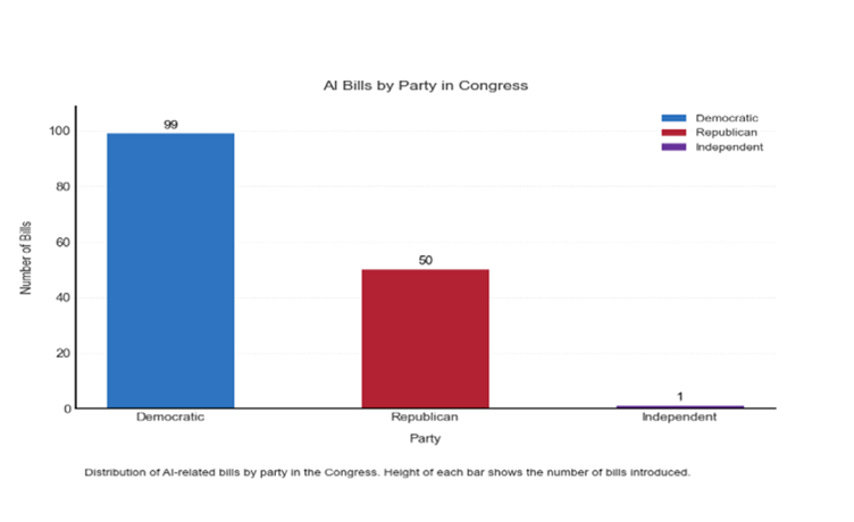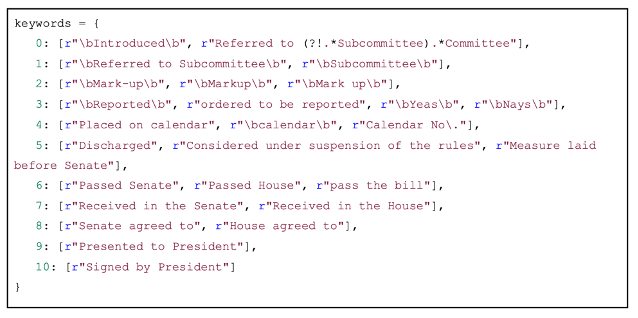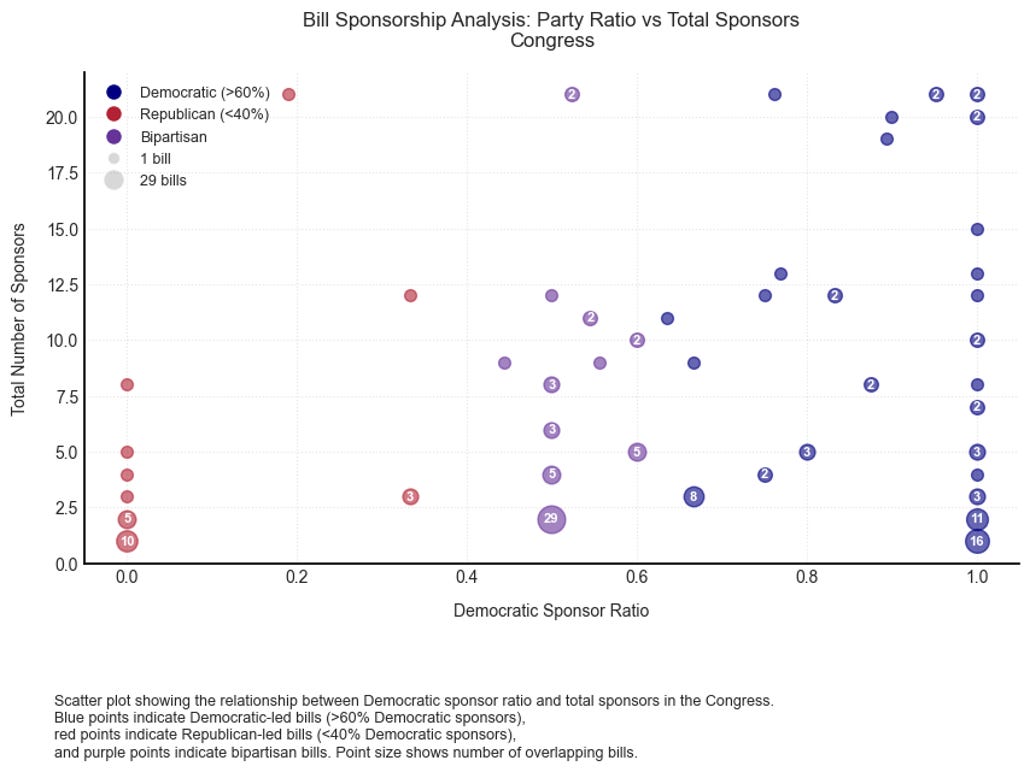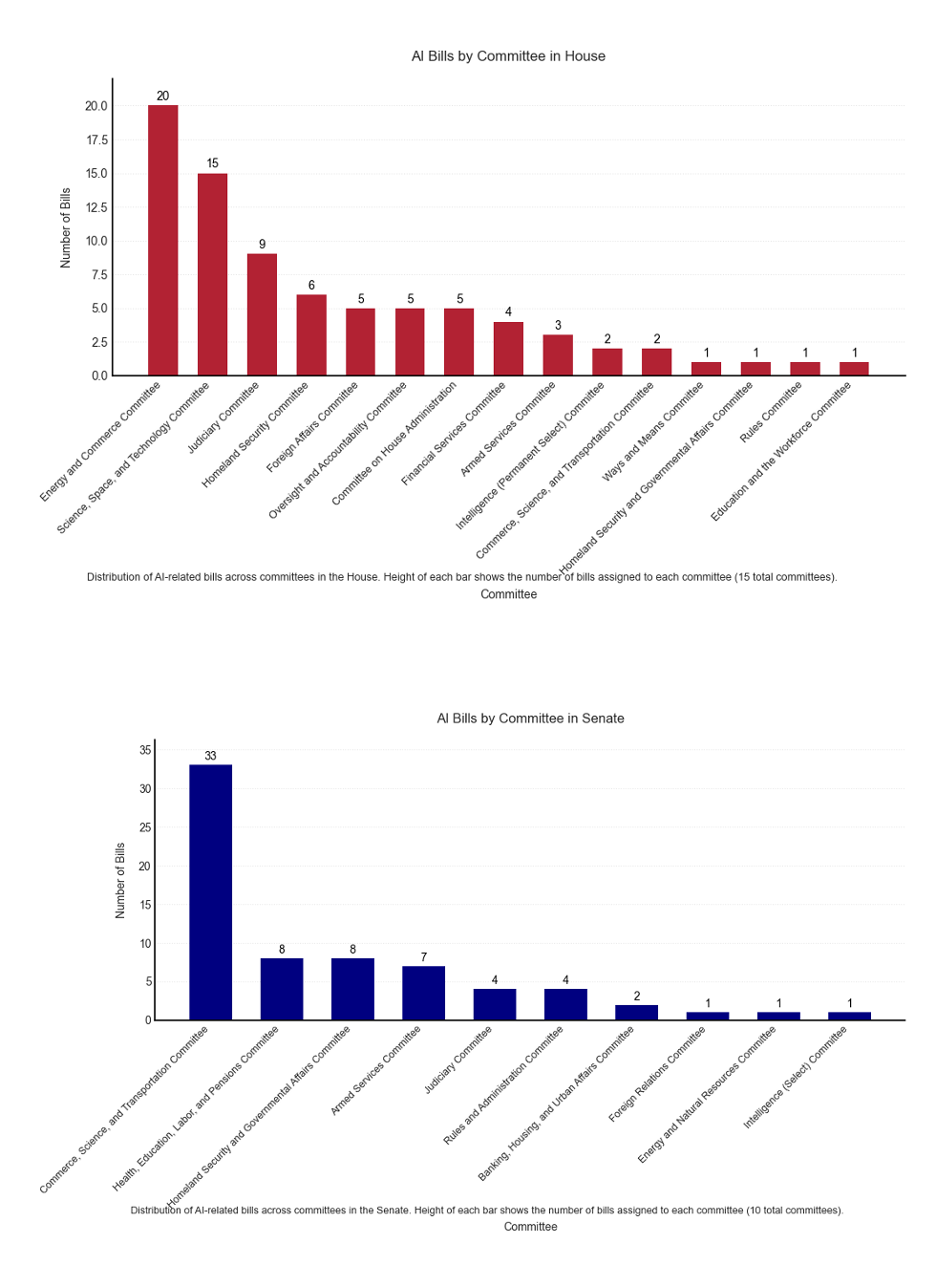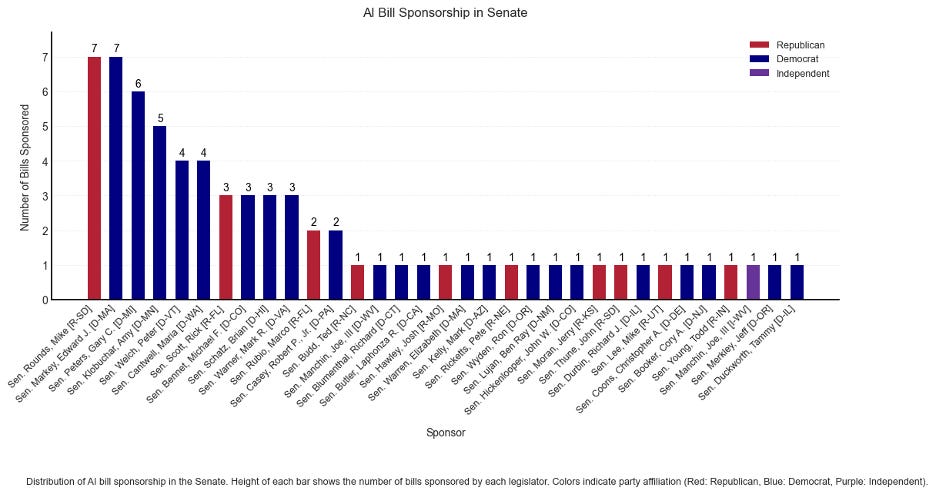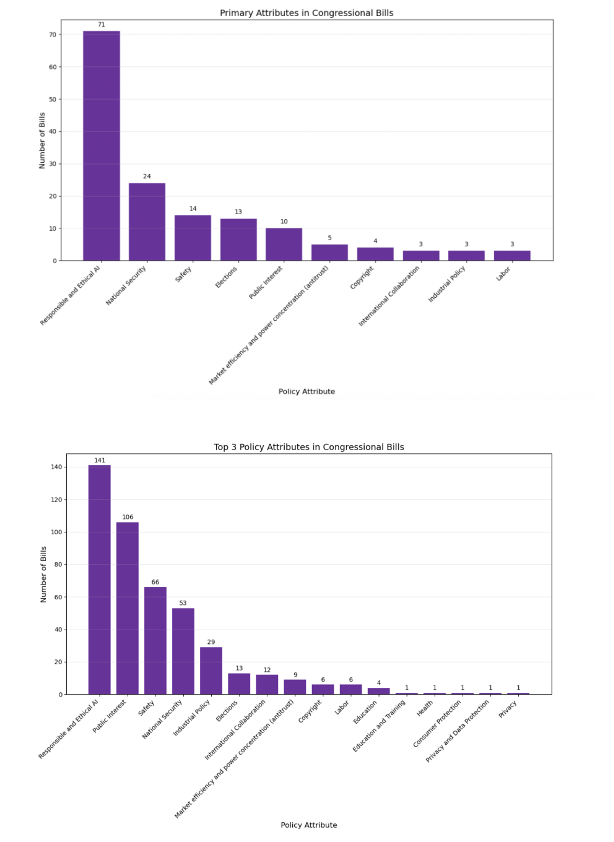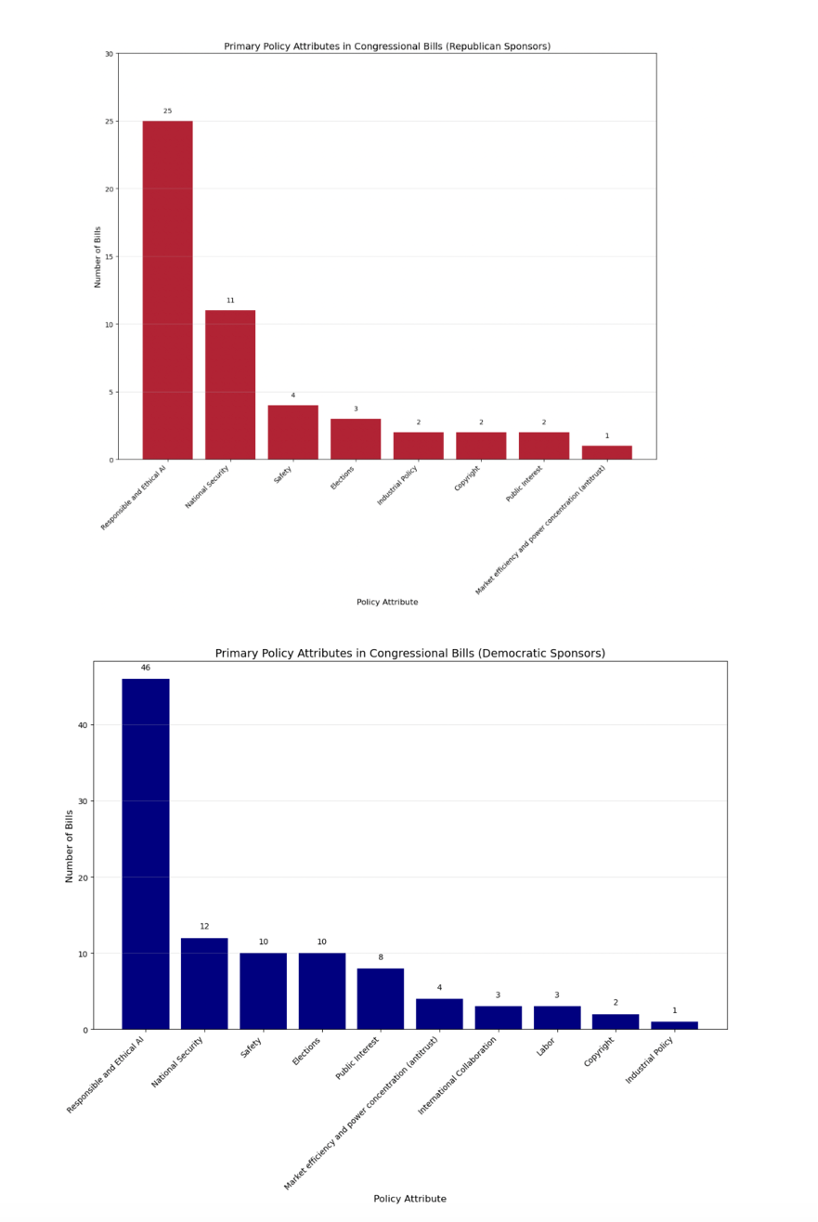A Quantitative Analysis of AI Federal Bills
Learning from the 150 AI-related bills introduced during the 118th legislature
This is the next in a series of excerpts from my paper “Governance at a Crossroads.”
What follows is a quantitative analysis of all AI-related bills introduced in the Federal Congress during the 2023-2024 session. None have been enacted into law.
The first part of the piece summarizes the findings and the second part includes additional data visualizations and explains how we did the analysis, and the data and natural language processing (AI) techniques used.
The technical work has been done in partnership with students from the Harvard Undergraduate Machine Intelligence Community (HUMIC) led by Brian Zhou and Shaurya Jeloka.
We used the Brenner Center for Justice Artificial Intelligence Legislation Tracker as our source for the federal AI bill inventory and the Congress.gov APIs to access detailed bill texts and associated metadata. Applying Machine Learning techniques, we identified and clustered patterns from the thousands of pages covered by these federal bills.
What follows is a quantitative analysis of the 150 AI-related bills introduced by the 118th Congress, revealing several key insights. The number is significantly higher than in previous sessions, indicating growing interest and concern among lawmakers regarding AI governance. Two-thirds of these bills have been introduced by Democrats (99 of the 150), suggesting a greater focus on AI policy within the Democratic Party.
Sponsorship clusters in the Democratic (72) and Bipartisan (54) categories indicate significant cross-party support for several initiatives despite the partisan divide on many issues. The total number of sponsors varies widely across bills, indicating diverse levels of support and coalition-building for different AI initiatives. Some bills have many sponsors but a relatively balanced partisan ratio, suggesting specific AI issues attract support from both parties.
Members from 36 states introduced AI bills, indicating that this is not a localized issue. During the 2024 legislative session, at least 45 states, Puerto Rico, the Virgin Islands, and Washington, D.C., introduced AI bills at the state level. Of these, 31 states, Puerto Rico, and the Virgin Islands adopted resolutions or enacted legislation.
Senators Mike Rounds [R-SD], co-chair of the Senate AI Caucus and member of the Senate’s bipartisan AI working group, and Edward Markey [D-MA] sponsored the most AI bills in the Senate, with seven each. Representative Ted Lieu [D-CA], co-chair of the House’s Bipartisan Taskforce on Artificial Intelligence, sponsored five bills, followed by representatives Clay Higgins [R-LA], Sheila Jackson Lee [D-TX], and Anna Eshoo [D-CA] with three sponsored bills each.
The Energy and Commerce Committee has been assigned the most AI bills in the House (20), followed by the Science, Space, and Technology Committee (15). The Commerce, Science, and Transportation Committee has been assigned the most AI bills in the Senate (33), followed by the Homeland Security and Governmental Affairs Committee (8), and the Health, Education, Labor and Pensions Committee (8).
Overall, the metadata analysis indicates a growing focus on AI governance, with participation by Congress members from most states. The Democratic Party is taking the lead but with significant bipartisan support. Even though the increase in AI-related bills reflects members’ newfound interest in the topic, our analysis showed that a few members continue to set the tone for the policymaking process.
The textual analysis of the 150 bills reveals the policy focus of each. The analysis of the "Primary Attributes in Congressional Bills" highlights the top emphasis lawmakers assigned to the bills. Responsible and Ethical AI emerges as the most common primary policy attribute, with 71 of the 150 bills mentioning it. This underscores a growing legislative concern for the ethical development and application of artificial intelligence. National Security follows with 24 bills, reflecting the importance to lawmakers of defense and security issues. In contrast, topics that dominate public discourse, such as Antitrust and Copyright, appear as primary attributes in only 5 and 4 bills, respectively.
The “Top 3 Policy Attributes in Congressional Bills” analysis provides an expanded view by considering three main policy attributes from each bill. This broader perspective brings attention to issues like Industrial Policy and Public Interest, which gain prominence when secondary attributes are factored in. Privacy and Data Protection remain low-priority areas, highlighted in only two bills. This aligns with the U.S. legislative trend of deferring to state-level leadership on privacy issues rather than enacting federal regulations.
When examining both scenarios, the legislative priorities of the 118th Congress become clear. Together, these analyses reveal a Congress grappling with AI ethics, national security, public interest, and a growing array of other critical issues. Lawmakers placed significant emphasis on the ethical development and use of AI and policies that serve the public interest. This focus aligns with Democratic Party priorities, which is unsurprising given that Democrats authored two-thirds of the bills.
However, the frequency of a policy attribute’s appearance does not necessarily indicate bipartisan consensus. Qualitative interviews provide deeper insight into areas of alignment, as discussed later in this text. For example, key terms like “safety” have become less favored in Republican circles, where “guardrails” is the preferred terminology. National security and global leadership - particularly concerning the U.S. energy matrix - emerged as pivotal topics during the late Biden administration and the early days of the new Trump administration. These areas are expected to remain central to legislative efforts in the 119th Congress.
How we did it
The primary objective of this analysis is to evaluate the breadth and depth of legislative activity related to AI within the 118th Congress, providing insights into emerging policy priorities, areas of bipartisan consensus, and potential gaps in regulatory approaches. By examining the content, partisanship, and progress of individual legislation, we aim to better understand the current scope of proposed AI legislation during this period (January 3, 2023, to January 3, 2025) and assess how lawmakers responded and prioritized challenges posed by AI.
This study offers a structured analysis of:
The key policy areas addressed by AI-related bills.
Patterns of sponsorship across partisan affiliations and geographic regions.
The progression and legislative success rates of AI-related proposals.
The extent of alignment between legislative efforts and industry perspectives on AI governance.
Data Methodology
Data Collection
We began by utilizing the Congress.gov API to retrieve all bills introduced into the House and Senate from the 118th Congress. At the start of the 119th Congress, the routes for api.congress.gov were changed. API calls are now done using gpo.congress.gov. From the information provided by the API, we stored the bill number, origin chamber, bill title, bill text, summary, and list of updates. The congressional API also includes its own broader policy area categorization that can be found on the API’s website.
From this dataset, fetched bills were filtered down to only the 150 bills in the 118th Congress that were manually identified by researchers at the Brennan Center as AI-related or AI-adjacent. For each identified bill, we gathered information about sponsorship patterns, committee assignments, and legislative progression. For each sponsor and cosponsor, we gathered district information, party affiliation, the day they sponsored, and whether they were an original sponsor or signed on after the bill was first introduced. This allowed us to assess the level of bipartisan cooperation and the likelihood of legislative success based on historical trends.
Data Cleaning and Preprocessing
Although the congressional API provides a detailed list of how bills progress in both chambers of Congress, the descriptions used to represent the status and progression of the bills contain inconsistencies. For example, the first markup of a bill can be entered in the API as “Mark-up”, “Markup”, or “Mark up”, while still representing the same action. We used regular expressions to harmonize different descriptions that had the same outcome to categorize bills into ten levels of progress, starting from the bill being introduced (Stage 0) to the bill being signed into law (Stage 10):
Stage 0 – Introduced
Stage 1 – Referred to Committee
Stage 2 – Referred to Subcommittee
Stage 3 – Reported Out of Committee
Stage 4 – Placed on Calendar
Stage 5 – Floor Consideration
Stage 6 – Passed One Chamber
Stage 7 – Received by Second Chamber
Stage 8 – Passed Second Chamber
Stage 9 – Presented to President
Stage 10 – Signed into Law
It is worth noting that the legislative process is not always conducted in an interactive, easy-to-follow fashion. Whenever the last action on the bill did not match a specific stage, we referred to the most recent stage that fit the categorization above.
Two bills from the dataset did not match any of the regular expressions:
S.B.3696, the DEFIANCE Act of 2024, passed the Senate and was “Held at the desk.” in the House, placing it at stage 7.
S.B.2103, the Intelligence Authorization Act for Fiscal Year 2024, had the last action “By Senator Warner from Select Committee on Intelligence filed written report. Report No. 118-59. Additional views filed.” The second-to-last action was the bill being placed on the Senate Legislative Calendar on 6/22/2023, placing it at stage 4.
Handling Missing Data
All bills were searched for missing data. Some bills were identified with missing summary fields and were supplemented with manual reviews in addition to the analysis of the bill text. Additional bills had duplicate metadata in the sponsor and cosponsor list, which were pruned to ensure accuracy.
Tagging Legislation
Selection of Policy Attributes
To identify legislative trends, we categorized bills into major policy domains, including national security, privacy and consumer protection, workforce impact, AI governance frameworks, and liability/accountability measures outlined in the list below. These categories were developed based on legislative text analysis and consultation with existing taxonomies of AI policy concerns as, for example, those from our AI Policy Considerations article.
Market efficiency and power concentration (antitrust)
Safety
Responsible and ethical AI
National security
Industrial policy
Public Interest
Labor
Copyright
International collaboration
Elections
NLP-Based Bill Classification
To enhance the categorization of AI-related legislation, we implemented Natural Language Processing (NLP) techniques to classify bill text on a first pass-through before conducting manual verification. This approach allowed us to systematically identify key policy themes, dominant topics, and relevant stakeholders embedded in legislative texts. The NLP methods applied included Term Frequency-Inverse Document Frequency (TF-IDF), Latent Dirichlet Allocation (LDA), and Named Entity Recognition (NER).
TF-IDF was used to identify first the most important keywords and rank policy focus areas. We tokenized each bill’s text into individual words and phrases and removed stop words (e.g., “the,” “and,” “is”) to improve relevance. After removing stop words, we applied TF-IDF weighting to score terms based on their frequency in a specific bill relative to their frequency across all bills in the dataset. Higher TF-IDF scores indicated terms uniquely important to each bill, revealing key legislative concerns.
Latent Dirichlet Allocation (LDA) was then used to allow the corpus to suggest dominant policy themes within AI-related legislation using an unsupervised machine learning approach. We identified latent structures within legislative text, allowing us to classify bills based on their primary focus areas. Bill text was tokenized to remove stop words, punctuation, and special characters to be converted into vectorized representations following the same process and vectors as TF-IDF. This allowed the methods to ensure that frequently occurring words that are uninformative (e.g., "bill," "committee," "section") did not distort results. The model then extracted the most probable words per topic, developing its own similar topics.
From a comparison of the proposed topics analyzed in TF-IDF and the topics examined in LDA, we observe that the most densely populated intersections show strong consistency across both techniques. For example, bills tagged as related to elections in TF-IDF overlap significantly with the proposed topics of government oversight and public safety, and bills tagged as market efficiency in TF-IDF overlap significantly with regulatory frameworks in LDA.
Validation with GPT
GPT has been demonstrated to perform on par and exceed the performance of Bidirectional Encoder Representations from Transformers (BERT) on classification and labeling tasks. We validated the proposed labels using GPT-4o’s API using the same bill text processing techniques.
Sponsorship & Partisanship
To analyze sponsorship and partisanship, we extracted the processed sponsorship data using the Congress.gov API, identifying key attributes for each AI-related bill:
● Primary Sponsor Information:
○ Legislator name, party affiliation (Democratic, Republican, Independent), and chamber (House/Senate)
○ Whether the legislator had previously introduced AI-related legislation
● Cosponsor Information:
○ Number of cosponsors, including the same information as the primary sponsor
○ Whether cosponsors joined at the time of the bill’s introduction or later in the legislative process
● Committee Assignments:
○ Committees responsible for reviewing each bill, including major AI-focused committees such as the:
House Science, Space & Technology Committee
Senate Commerce, Science & Transportation Committee
House Judiciary Committee
enate Armed Services Committee
● Bill Progression Tracking:
○ Legislative stage (e.g., introduced, passed committee, enacted into law).
○ Relationship between bipartisan sponsorship and legislative success rates.
Overall, Democrats introduced twice as many bills related to AI in the 118th Congress compared to Republicans, although the gap was more pronounced in the Senate and less pronounced in the House.
Committee Influence on AI Legislation
In Congress, the Senate Commerce, Science & Transportation Committee reviewed nearly half of all bills referred to committee in the Senate. However, the House was split more evenly, with a near-majority of bills going for review split between the House Energy and Commerce Committee and the House Science, Space, and Technology Committee. This is likely due to the split of commerce from the science committee in the House, whereas the two are merged in the Senate.
Legislative Success
Although a large number of bills related to AI were introduced, only 11.3% made it out of committee, calculated by evaluating the progress data as defined in the data preprocessing step.




